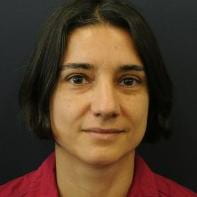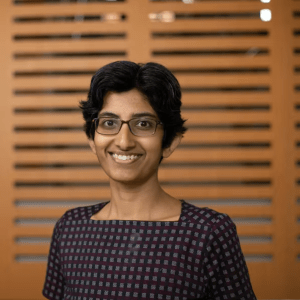Reka Albert (Penn State University)

Title: Connecting Network Structure, Dynamics, and Control
Abstract: My group is using network science and dynamic modeling to understand the emergent properties of biological systems. Although most of our work is on specific processes that underlie cellular phenotypes, we are also seeking to draw general conclusions that connect a network’s structure and dynamics. We are developing concepts and methodologies that are applicable to any network and any dynamic modeling framework (although our starting point is Boolean modeling). Such a general connection is our identification of stable motifs, which are self-sustaining cyclic interaction structures that determine trap spaces of the system’s state space. We have elucidated a system’s decision-making as a choice between two mutually exclusive stable motifs and have shown that the control of stable motifs can guide the system into a desired phenotype. We have recently developed the software library pystablemotifs, which implements efficient algorithms to determine and control any Boolean system’s attractor repertoire.
Shankar Bhamidi (University of North Carolina at Chapel Hill)
 Title: Dynamic Networks: One Has to Do the “Math”
Title: Dynamic Networks: One Has to Do the “Math”
Abstract: Models for networks that evolve and change over time are ubiquitous in a host of domains, including modeling social networks, understanding the evolution of systems in proteomics, the study of the growth and spread of epidemics, etc. This talk will give a brief summary of three recent findings in this area: (a) Understanding the effect and detectability of change point in the evolution of the system dynamics; (b) Reconstructing the initial “seed” that gave rise to the current network, sometimes referred to as Network Archeology; (c) The disparity in the behavior of different centrality measures, such as degree and page rank centrality for measuring popularity in settings where there are vertices of different types such as majorities and minorities as well as issues with sampling rare groups within the network. The main goal will be to convey unexpected findings in each of these three areas. Based largely on joint work with Sayan Banerjee, Iain Carmichael, Nelson Antunes, and Vladas Pipiras.
Yuguo Chen (University of Illinois Urbana-Champaign)
 Title: Inferring Social Influence in Dynamic Networks
Title: Inferring Social Influence in Dynamic Networks
Abstract: An interesting problem in social network analysis is whether individuals’ behaviors or opinions spread from one to another, which is known as social influence. The degree of influence describes how far the influence passes through individuals. Here, we explore the degrees of influence in dynamic networks. We build a longitudinal influence model to specify how people’s behaviors are influenced by others in a dynamic network. In order to determine the degrees of influence, we propose a sequential hypothesis testing procedure and use generalized estimating equations to account for multiple observations of the same individual across different time points. In addition, we show that the power of our proposed test goes to one as the network size goes to infinity. We illustrate the performance of our proposed method using simulation studies and real-data analyses.
Bruce Desmarais (Penn State University)
 Title: Estimating Latent Diffusion Networks with Event History Models
Title: Estimating Latent Diffusion Networks with Event History Models
Abstract: Research on the diffusion of political decisions across jurisdictions typically accounts for units’ influence over each other with (1) observable measures or (2) by inferring latent network ties from past decisions. The former approach assumes that interdependence is static and perfectly captured by the data. The latter mitigates these issues but requires analytical tools that are separate from the main empirical methods for studying diffusion. As a solution, we introduce network event history analysis (NEHA), which incorporates latent network inference into conventional discrete-time event history models. We demonstrate NEHA’s unique methodological and substantive benefits in applications to policy adoption in the American states. Researchers can analyze the ties and structure of inferred networks to refine model specifications, evaluate diffusion mechanisms, or test new or existing hypotheses. By capturing targeted relationships unexplained by standard covariates, NEHA can improve models,
Yang Feng (New York University)

Title: Pairwise Covariates-Adjusted Block Model for Community Detection
Abstract: One of the most fundamental problems in network study is community detection. The stochastic block model (SBM) is one widely used model with different estimation methods developed with their community detection consistency results unveiled. However, the SBM is restricted by the strong assumption that all nodes in the same community are stochastically equivalent, which may not be suitable for practical applications. We introduce a pairwise covariates-adjusted stochastic block model (PCABM), a generalization of SBM that incorporates pairwise covariate information. We study the maximum likelihood estimates of the coefficients for the covariates as well as the community assignments. It is shown that both the coefficient estimates of the covariates and the community assignments are consistent under suitable sparsity conditions. Spectral clustering with adjustment (SCWA) is introduced to efficiently solve PCABM. Under certain conditions, we derive the error bound of community detection under SCWA and show that it is community detection consistent. In addition, the model selection in terms of the number of communities and the feature selection for the pairwise covariates are investigated, and two corresponding algorithms are proposed. PCABM compares favorably with the SBM or degree-corrected stochastic block model (DCBM) under a wide range of simulated and real networks when covariate information is accessible.
Tracy Ke (Harvard University)

Title: Optimal Network Membership Estimation under Severe Degree Heterogeneity
Abstract: Real networks often have severe degree heterogeneity. We are interested in studying the effect of degree heterogeneity on the estimation of the underlying community structure. We consider the degree-corrected mixed membership model (DCMM) for a symmetric network with n nodes and K communities, where each node i has a degree parameter θi and a mixed membership vector πi. The level of degree heterogeneity is captured by Fn(·) – the empirical distribution associated with n (scaled) degree parameters. We first show that the optimal rate of convergence for the l1-loss of estimating πi’s depends on an integral with respect to Fn(·). We call a method optimally adaptive to degree heterogeneity (in short, optimally adaptive) if it attains the optimal rate for arbitrary Fn(·). Unfortunately, none of the existing methods satisfy this requirement. We propose a new spectral method that is optimally adaptive, the core idea behind which is using a pre-PCA normalization to yield the optimal signal-to-noise ratio simultaneously at all entries of each leading empirical eigenvector. As one technical contribution, we derive a new row-wise large-deviation bound for eigenvectors of the regularized graph Laplacian.
Jing Lei (Carnegie Mellon University)
 Title: Spectral Clustering for Heterophilic Stochastic Block Models with Dynamic Node Memberships
Title: Spectral Clustering for Heterophilic Stochastic Block Models with Dynamic Node Memberships
Abstract: Longitudinal and temporal analyses of a network reveal insights into how communities of nodes lose or create new creations over time. Due to the complexity of most networks, statistical methods are a necessity to uncover these broad dynamics. We provide new theory and methods in this area by providing a method that is computationally efficient and can handle a wide range of network dynamics. Our method combines the nonparametric smoothing and dynamic network frameworks, revealing a bias-variance trade-off in temporal network smoothing, together with a data-driven tuning parameter selection procedure. The proposed method shows promising performance in a thorough investigation of the scRNA-seq data.
Martina Morris (University of Washington)
 Title: ERGMs: Niche or Necessary?
Title: ERGMs: Niche or Necessary?
Abstract: With their strange acronyms, interdisciplinary identity and limited curricular reach, Exponential-family Random Graph Models for networks seem to be in an extended struggle for broad acceptance and recognition. This talk will invite the audience to think about the scientific value of this modeling class, its unique contributions and challenges, the role of software and data in limiting or extending its reach, and consider the implications for future developments.
Sarah Rajtmajer (Penn State University)
 Title: Networked Disinformation: International Influence Operations on Twitter
Title: Networked Disinformation: International Influence Operations on Twitter
Abstract: In June 2020, Twitter took down and released a set of accounts linked to Turkey’s ruling political party (AKP). We investigate these accounts in the aftermath of the takedown to explore whether AKP-linked operations are ongoing and to understand the strategies they use to remain resilient to disruption. We collect live accounts that appear to be part of the same network, ~30% of which have been suspended by Twitter since our collection. We create a BERT-based classifier that shows similarity between these two networks, develop a taxonomy to categorize these accounts, find direct sequel accounts between the Turkish takedown and the live accounts, and find evidence that Turkish IO actors deliberately construct their network to withstand large-scale shutdown by utilizing explicit and implicit signals of coordination. We compare our findings from the Turkish operation to Russian and Chinese IO on Twitter and find that Turkey’s IO utilizes a unique group structure to remain resilient. Our work highlights the fundamental imbalance between IO actors quickly and easily creating free accounts and the social media platforms spending significant resources on detection and removal and contributes novel findings about Turkish IO on Twitter.
Purnamitra Sarkar (University of Texas at Austin)
 Title: Subsampling and Jackknife for Networks
Title: Subsampling and Jackknife for Networks
Abstract: Networks show up in a variety of applications, starting from social networks to brain networks in neuroscience, from recommender systems to the internet, from who-eats-whom networks in ecosystems to protein-protein interaction networks. An important question that often arises is centered around estimating the underlying distribution of network statistics, like eigenvalues, subgraph densities, etc. In this talk I will discuss our work on subsampling and the jackknife for these inferential tasks. Despite the dependence of network data induced by edges between pairs of nodes, under the graphon model, we show that jackknife and subsampling largely behave similarly to their IID counterparts. This is joint work with Robert Lunde and Qiaohui Lin.
Ji Zhu (University of Michigan)
 Title: Network Community Detection Using Higher-Order Structures
Title: Network Community Detection Using Higher-Order Structures
Abstract: Many real-world networks commonly exhibit an abundance of subgraphs or higher-order structures, such as triangles and by-fans, surpassing what is typically observed in randomly generated networks (Milo et al., 2002). However, statistical models accounting for this phenomenon are limited, especially when community structure is of interest. This limitation is coupled with a lack of community detection methods that leverage subgraphs or higher-order structures. In this paper, we propose a novel community detection method that effectively incorporates these higher-order structures within a network. We also develop a finite-sample error bound for community detection accuracy under an edge-dependent network model, which includes both community and triangle structures. This error bound is characterized by the expected triangle degree, leading to the proposed method’s consistency. To our knowledge, this is the first statistical error bound and consistency result considering a single network’s community detection under a network model with dependent edges. Through simulations and a real-world data example, we demonstrate that our method reveals network communities otherwise obscured by methods that disregard higher-order structures.